Wasps

Wasps on the summer cottage or in the wild can be found, eating almost everything. They spoil the grapes and blackberries, feed on raspberries and ripe plums, in large quantities flock to meat and fish. And while books and encyclopedias still claim that wasps are predators, and in large quantities eat insects. It may seem that these stinging arthropods are absolutely omnivorous. But in reality it is not so - the wasps have rather strict food habits, which are well understood if you get to know them better. What do they actually eat? ..
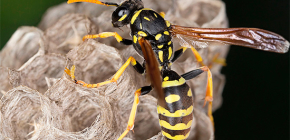
It is one thing when wasps fly from time to time, for example, on the veranda of a private house, and quite another when insects build their nest in the attic, in the shed or even in the toilet located on the plot. If in the first case one wasp can be easily slammed or simply driven away, then near the nest there is a real threat of constant attacks of wasps on people and domestic animals.In order not to put themselves at risk of being bitten, in such cases it is highly desirable to get the wasps out of the house or from the territory of the plot as soon as possible, since they have made their nest here. On how to carry out the procedure of getting rid of insects effectively and at the same time safe for your health, we will continue and talk ...
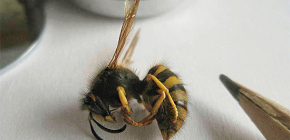
Do you think the wasp has a sting? It may seem strange, but for many people the answer to this simple question is far from obvious, because after the bite of a wasp, unlike bees, there is no sting in the skin. Let's take a closer look at what and how exactly the wasps bite - with their jaws or with the sting with which they, like bees, inject poison under the victim's code ...

Mention of the benefits of bee venom today can be found even in serious literary sources, and in folk medicine it has long been widely used to treat a wide variety of diseases. And could it be as useful asp poison? After all, it is known that wasps sting more painfully than bees, which means that it can be assumed that their poison is stronger and, possibly, more effective.And after each bite, the wasp feels great and does not die, so the use of wasp venom for the benefit of human health would be absolutely humane with respect to the insect. Well, let's see if the waspic venom can really be useful and how much such benefits would outweigh the harm from it, as from biological toxin ...

In most cases, wasp bites do not pose a serious danger to humans, and the unpleasant consequences of them in the form of pain, swelling and itching pass quickly enough. However, in some situations, even a single wasp sting can be very, very dangerous, not to mention the cases when insects attack with a whole swarm. On the potential danger of wasp bites and their possible consequences, we will continue to talk in more detail.
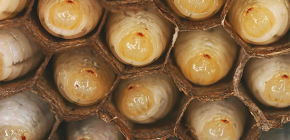
We all have a good idea of what the wasps look like, namely, their adult individuals, with a black-and-yellow striped coloring familiar to the eye. But not everyone can see the larvae of wasps: not only do adult insects carefully hide their offspring from prying eyes, so they also diligently protect the brood, fearlessly attacking anyone who dares to get close to the nest.Not surprisingly, most people can only guess how the wasp larvae look. Let's take a closer look at these "babies" living in wasp nests ...
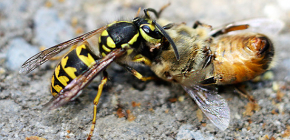
The wasps in the apiary are like a wolf in a sheepfold: these predators feed their larvae with insects, and also like to eat honey if such an opportunity presents itself. Moreover, some species of large wasps almost specialize in the destruction of bee colonies. It is not surprising that the apiary attracts striped predators, like a gypsy camp attracts lice and bedbugs. In some cases, wasps may even cause the death of a young or weakened bee family, so fighting with them in the apiary is relevant for many beekeepers and often requires a lot of time and effort. So, let's understand how to properly protect bees from wasps ...
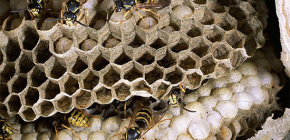
Wild wasps are very interesting, highly organized and quite nice creatures. The usual paper wasps, yellow with black dressings, which willingly flock to ripe grapes or fish on the verandah, as well as large and terrible hornets, the variety of wild wasps is not limited at all.These insects are found to us much more often than we think, just not all their ordinary urban dweller or summer resident perceives as wasps. Let's see how wild wasps are, how dangerous they can be, how these interesting insects build nests and look after their larvae ...

Did the wasps beat the grapes and turn the beautiful, shiny clusters into ragged rags? Unfortunately, this problem concerns many gardeners - and especially those who grow grapes for direct sale. And since many farmers have already managed to deal with this misfortune, various solutions have been found to protect grapes from insatiable insects. All you have to do is choose the method of protection that will be most effective, convenient and inexpensive in your case. Let's look at the various options for protecting the crop in more detail ...
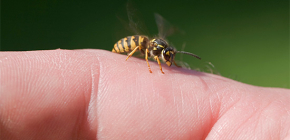
Although the wasp's bite feels in many ways similar to the bee's bite, but wasp venom is almost never used in traditional or traditional medicine.It would seem, why? And is the action of the poison of the wasp really a little different from the effect after getting into the fabric of bee sting? To answer these questions, let's try to figure out exactly how the wasp's poison acts on the human body and whether it can bring health benefits ...
